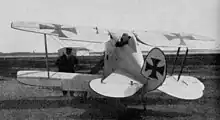DFW Floh
The DFW T.28 Floh (English: Flea) was a small German biplane fighter prototype designed by Hermann Dorner, the designer of the successful Hannover CL.II two-seat fighter of 1917, and built by Deutsche Flugzeug-Werke.[1]
| Floh | |
|---|---|
 | |
| DFW T.28 Floh cica 1915 | |
| Role | Biplane fighter aircraft |
| National origin | Germany |
| Manufacturer | Deutsche Flugzeug-Werke |
| Designer | Hermann Dorner |
| First flight | 1915 |
| Number built | 1 |
Designed in 1915 as high-speed fighter, the Floh had a small 6.20 m (20.3 ft) wingspan and a rather ungainly tall and thin fuselage.[1] With a fixed conventional landing gear the Floh was powered by a 100 hp (75 kW) Mercedes D.I inline piston engine, and on its first flight in December 1915 reached 180 km/h (110 mph), quite fast for the time.[1]
The aircraft suffered from very poor forward visibility and was difficult to land due to its narrow landing gear.[2] The prototype crashed during the flight testing programme.[1]

Specifications
Data from .[2]
General characteristics
- Crew: 1
- Length: 4.50 m (14 ft 9 in)
- Wingspan: 6.50 m (21 ft 4 in)
- Wing area: 15 m2 (160 sq ft)
- Empty weight: 420 kg (926 lb)
- Gross weight: 650 kg (1,433 lb)
- Powerplant: 1 × Mercedes D.I water-cooled inline piston, 75 kW (100 hp)
- Propellers: 2-bladed
Performance
- Maximum speed: 180 km/h (110 mph, 97 kn)
Armament
- 1 7.92mm (0.312 in) LMG 08/15 Spandau machine gun
References
Notes
- Orbis 1985, p. 1297
- "DFW T28 Floh". flyingmachines.ru. Their Flying Machines. Retrieved 18 July 2015.
Bibliography
- Herris, Jack (2017). DFW Aircraft of WWI: A Centennial Perspective on Great War Airplanes. Great War Aviation Centennial Series. Vol. 29. n.p.: Aeronaut Books. ISBN 978-1-935881-54-4.
- The Illustrated Encyclopedia of Aircraft (Part Work 1982-1985). Orbis Publishing.